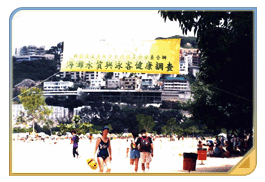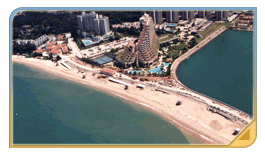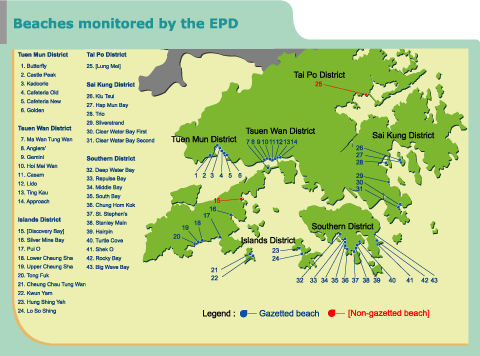 |
Since the EPD first took over the task of monitoring Hong Kong's beaches in 1986, its Beach Water Quality Monitoring Programme has been extensively refined, improved and extended. Today, the EPD is responsible for monitoring over 40 beaches across the territory. Besides its job of monitoring and analysing beach water samples, the EPD is also responsible for making information about Hong Kong's beaches available to all who may need it.
Before 1986, the task of monitoring Hong Kong's beach water was split between three different departments (the former Urban Services Department, Regional Services Department and Engineering Development Department). This system was neither efficient nor well-co-ordinated, and in 1986 the Government handed the responsibility for monitoring beach water quality to the newly-formed EPD. As mentioned in the Overview, the EPD devoted a great many resources to conducting the epidemiological studies that would establish a sound scientific basis for the Programme. The EPD also worked hard to ensure that monitoring was carried out efficiently and accurately, and that data about beach water quality was disseminated as widely as possible.

|
Hong Kong has a large number of beaches, some located surprisingly close to big urban centres and others accessible only by boat or a strenuous hike across the hills. All are beautiful, dramatic and ideal for relaxing on or swimming at during Hong Kong's many long, hot summer days. A number of the beaches are 'gazetted' by the Government, meaning they are maintained and managed for public use. For example, gazetted beaches have changing facilities, toilets and showers and are manned by lifeguards when they are open for swimming.
Back in 1986, a total of 41 of Hong Kong's beaches were gazetted. All of these were monitored by the EPD, together with a further 10 beaches that were then being considered for gazettal. Although twenty years later the number of gazetted beaches in Hong Kong remains at 41, the specific beaches making up this number have changed over time. For example, the beaches of Pak Sha Chau and Campers were de-gazetted in October 1995, while Butterfly Beach was gazetted in 1987 and Golden Beach in 1995. (The two de-gazetted beaches have been excluded from statistics and graphs in this Report).
Of the 41 gazetted beaches monitored in 2005, 32 were open during the
year and the other nine were closed to swimmers, seven because of poor
water quality and two because of low swimmer attendance and resource
considerations (a decision made by the Leisure and Cultural Services
Department). The EPD monitored water quality at all these gazetted beaches.
In addition, in 2005 the EPD monitored two non-gazetted beaches: Discovery
Bay Beach and Lung Mei Beach.
The frequency of monitoring has increased since the EPD began administering the Beach Water Quality Monitoring Programme in 1986. Originally, gazetted beaches were sampled once a fortnight during the bathing season only, while non-gazetted beaches received monthly monitoring. Over the years the EPD has adjusted the frequency of its monitoring periods at gazetted beaches to at least three times a month during the bathing season, and more frequently when a beach shows any sudden deterioration.
Across the entire year, the frequency of beach water monitoring varies depending on the season and the status of individual beaches. A few popular beaches are open all the year round: these include Clear Water Bay Second, Deep Water Bay, Golden and Silverstrand Beaches. At these beaches, the EPD takes water samples for the entire year, at least three times every month. Most other gazetted beaches are open to swimmers only for the bathing season between March and October (a few do not open until April, and a few finish their bathing season in November). During the season, the EPD takes samples from these beaches at least three times a month, while in the non-bathing season the frequency of sampling drops to once a month. The two non-gazetted beaches are monitored at least twice a month in the bathing season, and once a month outside it.

The EPD has developed simple but effective benchmark criteria for measuring environmental water quality. They are called the Water Quality Objectives (WQOs), and have been used by the EPD since the late 1980s. For bathing beaches, the WQO lays down the acceptable level of E. coli bacteria in beach water. E. coli is a good indicator of faecal pollution and levels of E. coli have been shown to be related to the incidence rate of swimming associated illnesses (such as skin and gastrointestinal illnesses).
The latest WQO for bathing beaches, revised in the 1990s, was based on epidemiological studies conducted on bathers at local beaches. It states that the level of E. coli should not exceed 180 per 100 mL, calculated as the geometric mean of all samples collected from March to October.
Each individual beach is tested regularly, and the results across the bathing season are used to ascertain if water at the beach meets the WQO. Testing works like this. EPD staff take samples of beach water at least three times every month (sometimes more often), and these samples are collected at between three- and fourteen-day intervals. The samples are analysed for E. coli bacteria and the results recorded. At the end of the bathing season, the EPD calculates the geometric mean of E. coli bacteria across all the samples taken. The figure is then compared with the WQO level of 180 per 100 mL.
The WQO for bathing beaches has an interesting history. When the EPD first took over the Beach Water Quality Monitoring Programme in 1986, the water quality objective in use stated that "the level of E. coli should not exceed 1,000 per 100 mL, calculated as the running median of the five most recent consecutive samples". This criterion was derived from criteria recommended by WHO in 1977, but not based on local epidemiological studies to show effects of beach water pollution on human health.
 
|
WHO had also strongly urged individual countries and regions to carry out their own scientific studies of beach water pollution, as a way of developing more accurate regionally-specific criteria for assessing water quality. The EPD initiated such research, and began a series of epidemiological studies in collaboration with scientists from local universities in the late 1980s. Its findings were clear: they confirmed that E. coli was the best bacterial indicator for assessing the incidence of diseases associated with swimming in the local population. They also established a significant linear relationship between the geometric mean of E. coli densities on the one hand, and the incidence of gastroenteritis and other illnesses associated with swimming on the other.
On the basis of these studies, the previous water quality objectives were revised in the early 1990s, linking water quality classification to specific health risks. This system, still in use today, provides a much more practical and scientifically-sound system for swimmers wanting to know the health risks of swimming at a particular beach.

